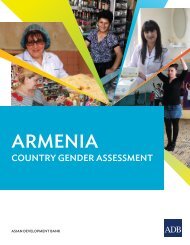Civic Activism as a Novel Component of Armenian Civil Society
English-3
English-3
Create successful ePaper yourself
Turn your PDF publications into a flip-book with our unique Google optimized e-Paper software.
Conclusion<br />
For the p<strong>as</strong>t two decades, <strong>Armenian</strong> civil society w<strong>as</strong> largely equated with the NGO sector.<br />
International development organisations, public <strong>of</strong>ficials, scholars and the few informed<br />
members <strong>of</strong> the general public regarded NGOs <strong>as</strong> the core element <strong>of</strong> <strong>Armenian</strong> civil society.<br />
The NGO sector is now relatively developed and institutionalised, but it is detached from the<br />
broader <strong>Armenian</strong> society. In that sense it remains a post-communist civil society. However, a<br />
new actor h<strong>as</strong> recently entered the civil society arena and made its presence visible. <strong>Civic</strong><br />
initiatives have been on the rise since circa 2007 and have already registered a number <strong>of</strong><br />
successes in affecting government decisions, despite the small numbers <strong>of</strong> people involved.<br />
Youth-driven, social-media-powered, issue-specific civic activism is a new form <strong>of</strong> protest and<br />
political participation. <strong>Armenian</strong> civil society is no longer simply a matter <strong>of</strong> NGOs, although<br />
NGOs unquestionably remain a crucial component <strong>of</strong> civil society. The landscape <strong>of</strong> <strong>Armenian</strong><br />
civil society h<strong>as</strong> changed.<br />
Focusing on NGOs when discussing civil society in a post-communist context is<br />
somewhat ironic, <strong>as</strong> the concept <strong>of</strong> civil society w<strong>as</strong> popularised in the late 1980s by referring to<br />
m<strong>as</strong>s mobilisation and social movements that challenged various countries’ communist regimes.<br />
As those movements lost momentum, NGOs came to replace them <strong>as</strong> the main ‘substance’ <strong>of</strong><br />
civil society. Empowered mostly through foreign development aid, rather than gr<strong>as</strong>sroots<br />
involvement, NGOs perform a wide range <strong>of</strong> t<strong>as</strong>ks, from humanitarian <strong>as</strong>sistance to advocacy,<br />
but fail to attract most <strong>Armenian</strong>s’ trust or interest in their cause.<br />
<strong>Armenian</strong> civil society is now unquestionably more complex than it w<strong>as</strong> ten or even five<br />
years ago. Ten years ago, civil society in Armenia largely meant NGOs. This is no longer the<br />
c<strong>as</strong>e. The emergence (or re-emergence, depending on one’s historical framework) <strong>of</strong> civic<br />
activism creates some new internal dynamics in the field <strong>of</strong> civil society, producing new patterns<br />
<strong>of</strong> operation, networking and mobilising. Both NGOs and civic initiatives have distinct modes <strong>of</strong><br />
functioning, strengths and weaknesses. They can and sometimes do complement one another.<br />
For example, NGOs <strong>of</strong>fer their expertise to the activist groups, while civic initiatives can<br />
energise NGOs and provide a much-needed link to the public. There is considerable evidence <strong>of</strong><br />
NGO members actively participating in civic initiatives <strong>as</strong> individuals. In general, NGOs, <strong>as</strong><br />
organisations, have thus far operated from behind the scenes, whether intentionally or<br />
unintentionally. Our research shows that there is both cooperation and tension between the ‘old’<br />
NGO sector and the ‘new’ civic activism elements <strong>of</strong> <strong>Armenian</strong> civil society.<br />
90



